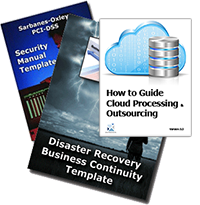Disaster Recovery High Risk Users
Individual users who pose high risks to and organization to disaster recovery planning efforts and when an event occurs...
Once a plan is created and an event occurs, failures can be predicted because of a few types of high risk individuals. When the plan is activated, they are the ones who are not prepared, "too busy" focusing on the wrong things, and are the first ones to blame someone else because their part of the recovery process did not work.
When you are creating your plan you need to be aware of these “personalities” and address them quickly.
- People who do not “participate” actively and often avoid documenting their procedures and backup/recovery processes
- People who never take a vacation or are the “sole” point of contact within a group because for whatever reason they are the only ones who know the big picture
- People who are the “heroes” who keep things running and are indispensable
Many organizations are either blind to the risk or reluctant to do something about these types of individuals, almost out of fear of upsetting the individual. This just hands them more power and the longer the situation persists the greater the risk to your organization.
Every organization has at least one of these personality types. As the individual responsible for your disaster recovery plan you should take the time to
- Identify who they are.
- Do not be held to ransom by these people - they could resign tomorrow
- Deal with it - take action before it's too late.
- De-personalize the situation - it's about your process not the individual.
Order DRP BCP Template DRP BCP Sample
DRP/BCP Tutorial; What is Disaster Recovery?; DRP BCP Basics; ISO 22301 ; ISO 27031; WEB e-commerce Sites; Types of Disasters; Why Plans Fail; Cloud Backup; Are You Prepared for a Disaster?; Pandemic; 10 Commandments of DR & BC Planning; 10 best practices Disaster Recovery Business Continuity, Risk Assessment; Process; Interruption Life Cycle ; Best Practices; Compliance Requirements; Media Communication; Facility Loss; Clean up - How To; Data Center Recovery Strategy;What to do after an explosion, terrorist attack, or random act of violence; Disaster Recovery and Business Continuity; Metrics; Calculating the cost of a Business Interruption; Funding; Funding Request Presentation; Maximum Tolerable Period of Disruption; Disaster Recovery Guide; Common Mistakes; Why Disaster Recovery Business Continuity is not complete and or inaccurate; Disaster Planning Template; Testing Options; Blackouts; Trends impacting DR/BC; 10 point power checklist DR/BC Event Infrastructure




